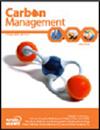Carbon dioxide mineralization by electrode separation for quick carbon reduction and sequestration in acidified seawater
IF 3.2
4区 环境科学与生态学
Q3 ENVIRONMENTAL SCIENCES
引用次数: 0
Abstract
Abstract Aiming to sequestrate the excessive carbon dioxide and convert the acidified seawater, an improved method of carbon dioxide mineralization is developed based on electrode separation mechanism and extra oxygen-supplying technique. By electrode separation the neutralizations of the anodic acidity and the cathodic alkalinity, as well as the precipitation and the dissolution of calcium carbonate (CaCO3), are prevented. In addition, the extra-supplied oxygen prevents the evolution of hydrogen, which enhances the electric conductivity of the porous cathode and the deposition of CaCO3. A series of indoor physical experiments were conducted and the results show that the acidified seawater was successfully converted to alkaline in 72h. The speed of carbon mineralizing sequestration is significantly enhanced by supplying extra oxygen. The carbon dioxide mineralization speed increases with the immerse ratio of the aerator due to the more reacted oxygen and the less hydrogen evolution, which gives more porous space in the cathode for more conductive seawater and more deposition of CaCO3. The extra-supplied oxygen increases the CaCO3 -deposition by 100-214% under excessive atmospheric- CO2 conditions and 117-200% under normal atmospheric- CO2 conditions, respectively. This method has an application potential for quick conversion of locally acidified seawater in emergent circumstances.电极分离二氧化碳矿化在酸化海水中的快速减碳和固碳
本文章由计算机程序翻译,如有差异,请以英文原文为准。
求助全文
约1分钟内获得全文
求助全文
来源期刊

Carbon Management
ENVIRONMENTAL SCIENCES-
CiteScore
5.80
自引率
3.20%
发文量
35
期刊介绍:
Carbon Management is a scholarly peer-reviewed forum for insights from the diverse array of disciplines that enhance our understanding of carbon dioxide and other GHG interactions – from biology, ecology, chemistry and engineering to law, policy, economics and sociology.
The core aim of Carbon Management is it to examine the options and mechanisms for mitigating the causes and impacts of climate change, which includes mechanisms for reducing emissions and enhancing the removal of GHGs from the atmosphere, as well as metrics used to measure performance of options and mechanisms resulting from international treaties, domestic policies, local regulations, environmental markets, technologies, industrial efforts and consumer choices.
One key aim of the journal is to catalyse intellectual debate in an inclusive and scientific manner on the practical work of policy implementation related to the long-term effort of managing our global GHG emissions and impacts. Decisions made in the near future will have profound impacts on the global climate and biosphere. Carbon Management delivers research findings in an accessible format to inform decisions in the fields of research, education, management and environmental policy.
 求助内容:
求助内容: 应助结果提醒方式:
应助结果提醒方式:


